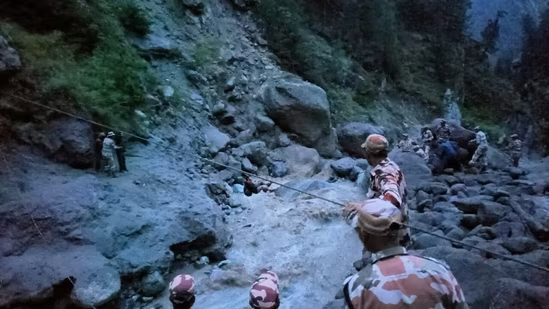
Himachal Pradesh
Himachal Pradesh, the serene hill state known for its lush valleys and snow-capped peaks, is grappling with severe disruptions caused by the relentless monsoon rains. As per the latest updates from the state emergency operations centre, 359 roads, 132 power lines, and 520 water supply schemes have been affected, leaving residents and tourists stranded while authorities race against time to restore normalcy.
Widespread Infrastructure Damage
The ongoing monsoon has triggered frequent landslides, road cave-ins, and flooding across several districts. The Public Works Department (PWD) reports that key highways and rural link roads have been rendered impassable due to heavy debris and rockfalls. These closures have not only disrupted daily life for locals but have also choked the supply of essential goods to remote areas.
Districts like Kullu, Mandi, Shimla, Chamba, and Kinnaur are among the worst hit. In many parts of these regions, road clearance work is hindered by continuous rainfall, which increases the risk of fresh landslides. The damage has also hampered tourist movement during what would otherwise be a peak travel season for Himachal.
Power Outages Add to the Woes
In addition to road blockages, the state is also facing widespread power outages. According to the Himachal Pradesh State Electricity Board, 132 electricity supply lines have been damaged, particularly in rural and high-altitude zones. Strong winds, heavy downpours, and lightning strikes have damaged poles, transformers, and cables, plunging several villages into darkness.
Restoration work is challenging in these weather conditions, as teams have to navigate dangerous, slippery slopes to access damaged infrastructure. Authorities have deployed additional manpower, but repairing high-tension lines in remote valleys remains a daunting task.
Water Supply Schemes Disrupted
The monsoon’s fury has also severely impacted the drinking water supply. Over 520 water supply schemes are reported to be damaged or disrupted, cutting off safe drinking water to thousands of households. Siltation in water sources, damage to pipelines, and flooding of pumping stations are among the primary reasons for the breakdown.
In some areas, local panchayats have been forced to arrange temporary water supply through tankers, but the hilly terrain and blocked roads have slowed down these relief measures.
Economic and Social Impact
The infrastructure damage has far-reaching consequences for Himachal Pradesh’s economy. The agriculture sector—particularly fruit growers—is facing losses due to transport bottlenecks. Apple growers in Shimla, Kullu, and Kinnaur are unable to move their produce to markets in time, leading to spoilage and financial distress.
The tourism industry, a significant contributor to the state’s income, has also taken a hit. Many visitors have cancelled bookings due to road closures and safety concerns. Small businesses dependent on tourist inflow—such as hotels, restaurants, and transport operators—are reporting heavy losses.
Socially, the disruption of basic utilities is impacting daily life, education, and healthcare. In several rural areas, health centres are struggling to function without consistent electricity or water supply, raising concerns about sanitation and disease outbreaks.
Government Response and Relief Efforts
The Himachal Pradesh government has activated its disaster management machinery at full capacity. PWD teams, electricity board workers, and irrigation & public health (IPH) department staff are working round the clock to restore connectivity and essential services.
Chief Minister Sukhvinder Singh Sukhu has instructed district administrations to prioritize clearing major highways, restoring power supply, and ensuring clean drinking water in affected areas. The state has also sought assistance from the central government for funds and technical support.
Rescue teams from the State Disaster Response Force (SDRF) and National Disaster Response Force (NDRF) are on standby for emergency evacuations in case of further landslides or flash floods. Authorities have also urged residents to avoid unnecessary travel and to stay updated on weather alerts.
Weather Outlook and Precautionary Measures
The India Meteorological Department (IMD) has forecast more heavy rainfall in parts of Himachal over the next few days. This has prompted warnings for possible landslides, flash floods, and river swelling in vulnerable districts. The administration is monitoring rivers like Beas, Sutlej, and Ravi, which are flowing close to danger levels in certain stretches.
Authorities have advised people to stock essential supplies, avoid crossing swollen streams, and stay away from unstable slopes. Tourists have been urged to check road conditions before travelling and to postpone non-essential trips until the weather stabilizes.
A Call for Long-Term Solutions
While immediate restoration work is underway, experts emphasize the need for long-term climate resilience measures in Himachal Pradesh. The increasing frequency of extreme weather events is a reminder that the state must invest in stronger infrastructure, better drainage systems, and stricter land-use planning to reduce vulnerability.
Environmentalists also point out that rampant construction on fragile slopes and deforestation have exacerbated the impact of monsoon rains. Strengthening early warning systems and improving coordination between agencies could help mitigate future damage.
Himachal Pradesh’s current crisis underscores how vulnerable mountain states are to the intensifying effects of climate change. For now, the priority remains restoring roads, power lines, and water schemes, but the lessons learned this monsoon season could shape a safer and more resilient future for the state.
Thanks For Reading